“All that is gold does not glitter, not all who wander are lost.”
J.R.R. Tolkien, The Fellowship of the Ring
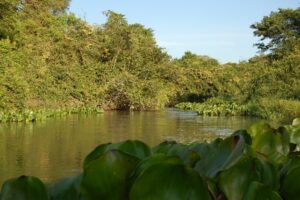
The Pantanal, the marshland, it is called. The world’s largest tropical wetland (>75,000 sq. mi.) lies mostly in the Brazilian state of Mato Grosso de Sul. From my home in Sullivan County, Indiana, it is over four thousand miles to this remarkable place. Nearly two decades have passed since I visited those wetlands and experienced their extraordinary diversity of plants and animals. But my memory of o Pantano still occasionally comes maneuvering to the surface. Like a great bass lured to a plopping, gurgling Jitterbug and slowly emerging from deep waters, the recollection of the Pantanal will rise, and I feel again its alluring tug.
The biodiversity to be found there is staggering in its variety. Few places offer a greater wildlife spectacle. Capybara and anaconda, snail kite and apple snail, giant anteater and giant otter, water hyacinth and monkey jelly plant, jaguar and jacaranda may all be seen in this vast and celebrated wetland world. For those of us who cherish wild places and the wild things which live there, a visit to the Pantanal is not easily forgotten.
Like a 21st Century Walter Mitty, I recall my journey to Brazil as a difficult and grueling one. The trip involved thirteen hours of air travel (Indy – Miami – Sao Paulo – Campo Grande). This was topped off by another six hours by minibus over roads of varying degrees of soundness. But then, I recall reading The River of Doubt, an account of Theodore Roosevelt’s harrowing experience in Brazil. I am abruptly reminded that my visit was a comparative walk in the park.
In 1913, Roosevelt was invited to give a series of lectures in the country. While there, he found himself with an opportunity to join an expedition organized by the Brazilian explorer Cândido Rondon. Rondon’s goal was exploration of a recently discovered and still uncharted river known as the Rio da Duvida.
Roosevelt enthusiastically joined the expedition, a trip which evolved into much more than he had anticipated. It took the team nearly two months of grim slogging just to reach the headwaters of the river. There then followed another three months of travel upon the Rio da Duvida made hellish by malaria, lethal rapids, damaged canoes, and inadequate supplies. Roosevelt and his son Kermit barely survived the trip.
Make no mistake, a trip to the Brazilian outback is absolutely an adventure, but these days it can be done in a mode of convenience which would likely have astounded our former President.
One of the most popular ways to explore the Pantanal is by utilizing one of the fazendas (ranches) which serve the dual purposes of cattle rearing and 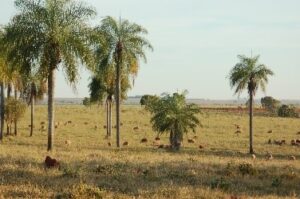 ecotourism. The last six miles of road into “our” fazenda, the Refugio da Ilha, consisted of a narrow, gravel track which traversed a mixture of pastureland and cerrado, the palm-dotted savannah of Brazil. Occasionally in the distance, the absurdly beautiful, pink blossoms of a Tabeuia or trumpet tree could be seen
ecotourism. The last six miles of road into “our” fazenda, the Refugio da Ilha, consisted of a narrow, gravel track which traversed a mixture of pastureland and cerrado, the palm-dotted savannah of Brazil. Occasionally in the distance, the absurdly beautiful, pink blossoms of a Tabeuia or trumpet tree could be seen
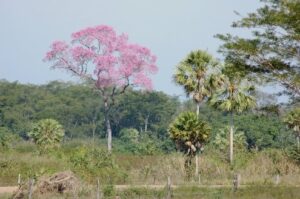
rearing above the dry grasses. Before even reaching the fazenda, we were given a hint that our time here would be rewarding. Scanning our surroundings for wildlife, we spotted a pair of strikingly cobalt-colored hyacinth macaws. We lingered and watched as they foraged for fruits high in an acuri palm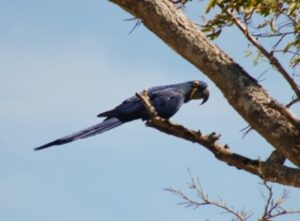 tree along the roadway. With a body length of just over three feet, these are the largest of the parrot species. Stunningly beautiful, as well as endangered, these parrots were near the top of our list of hoped-for bird sightings.
tree along the roadway. With a body length of just over three feet, these are the largest of the parrot species. Stunningly beautiful, as well as endangered, these parrots were near the top of our list of hoped-for bird sightings.
Arriving at Refugio da Ilha, we found the main house to be a low slung,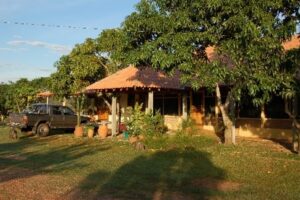 spacious collection of sleeping quarters, sitting rooms, dining areas, and kitchens. The ranch was set upon ten thousand acres of Brazilian real estate. Twenty-five hundred acres of this expanse were devoted to cattle ranching, while the remaining seventy-five hundred formed a vast and beguiling nature preserve.
spacious collection of sleeping quarters, sitting rooms, dining areas, and kitchens. The ranch was set upon ten thousand acres of Brazilian real estate. Twenty-five hundred acres of this expanse were devoted to cattle ranching, while the remaining seventy-five hundred formed a vast and beguiling nature preserve.
Outside the house a covered shelter held one of the traditional wood-fired ovens (the forno) of Brazil. There were also dining tables for many guests. Surrounding the buildings were shade-covered lawns with hammocks invitingly suspended from the trees. The banks of the nearby cattle-watering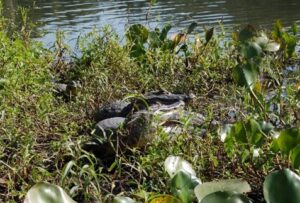 ponds were festooned with basking spectacled caimans. Along one side of the lawn ran a small, gently flowing river called the Salobra. This tiny river was to provide many hours of delightful wildlife viewing in the days to come.
ponds were festooned with basking spectacled caimans. Along one side of the lawn ran a small, gently flowing river called the Salobra. This tiny river was to provide many hours of delightful wildlife viewing in the days to come.
Almost immediately upon our arrival, and following salutations, we were invited to gather at the outdoor dining area for lunch. Our first meal at Refugio da Ilha was also a harbinger of delights to come. The food was mouthwateringly good. Beef ribs cooked over the wood fire were accompanied by fried egg plant, rice and beans (ever-present in Central and South American meals), corn, manioc, and beets. How wonderful such a simple, but well-prepared meal can be when it is supplemented by a sharp hunger and is taken outside in a sublime setting. As we dined under the shade trees, we chatted with the adult children of the ranch’s owners and heard plans for our first outing on the reserve.
come. The food was mouthwateringly good. Beef ribs cooked over the wood fire were accompanied by fried egg plant, rice and beans (ever-present in Central and South American meals), corn, manioc, and beets. How wonderful such a simple, but well-prepared meal can be when it is supplemented by a sharp hunger and is taken outside in a sublime setting. As we dined under the shade trees, we chatted with the adult children of the ranch’s owners and heard plans for our first outing on the reserve.
Having served the purpose of rice farming, parts of the fazenda were crisscrossed by dikes which once held the waters of the rice fields. These now made for exceptionally fine walking and wildlife viewing. The dikes were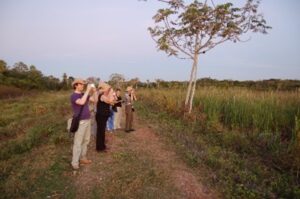 wide, level, and passed through highly productive wetland habitat. It was along these elevated pathways that we took our first stroll through the Pantanal.
wide, level, and passed through highly productive wetland habitat. It was along these elevated pathways that we took our first stroll through the Pantanal.
Large areas of wetlands filled with papyrus, sedges, and emergent grasses surrounded us. Groves of caranda palm were interspersed with expanses of wetland herbaceous plants. This mixture of habitats made it a veritable paradise for wildlife.
During our three-mile jaunt, we surprised a feeding marsh deer and watched as it leaped, without hesitation, into an adjacent knee-deep pool. Across the morass it raced, water spewing from its whirling legs, as it rushed toward the safety of the nearby forest. Later we were able catch a glimpse of the deer’s smaller cousin, a gray brocket deer, as it stealthily crept out of sight into a palm grove.
A small herd of white-lipped peccaries, busily rooting for food, shared the area with these deer. Occasionally we heard them clacking their teeth loudly. This behavior helped maintain group contact but was also a reminder for other animals to steer clear of these potentially aggressive, pig-like mammals. The spoor of South American tapir and capybara were also found during our ramble. These signs were reminders that there were other wonders present here, even though they might exercise their uncanny ability to remain hidden to us.
But oh my, the birds! Unlike the secretive mammals, so often bent on making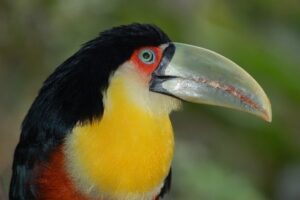 themselves unseen, the avian residents of the wetland showed no such hesitancy. They were more than willing to flaunt their gorgeous plumage and diversity of form. The fact that birds are, unlike many other animal groups, often easily seen and simultaneously beautiful, makes birding one of the most popular outdoor activities in the world. We saw dozens of species on that first walk. There is a thrill, as well as a sense of satisfaction, in seeing a previously unseen bird species. On this walk I saw my
themselves unseen, the avian residents of the wetland showed no such hesitancy. They were more than willing to flaunt their gorgeous plumage and diversity of form. The fact that birds are, unlike many other animal groups, often easily seen and simultaneously beautiful, makes birding one of the most popular outdoor activities in the world. We saw dozens of species on that first walk. There is a thrill, as well as a sense of satisfaction, in seeing a previously unseen bird species. On this walk I saw my first rufescent tiger heron, first snail kite, first wood rail, first black-hooded parakeet. Each one was a reminder that the biological diversity of our amazing planet is even greater than we imagine.
first rufescent tiger heron, first snail kite, first wood rail, first black-hooded parakeet. Each one was a reminder that the biological diversity of our amazing planet is even greater than we imagine.
But then, of course, there was still the Rio Salobra to explore.  There are few more enjoyable ways to reconnoiter new territory than by water. With minimal exertion (thanks to a worthy boatman), and in stealthy silence, one is free to drift along devoting full attention to each new scene looming around the bend.
There are few more enjoyable ways to reconnoiter new territory than by water. With minimal exertion (thanks to a worthy boatman), and in stealthy silence, one is free to drift along devoting full attention to each new scene looming around the bend.
In some places, the Salobra was perhaps twenty or thirty yards wide. In other spots, where the water hyacinth flourished, there might be only a narrow path of open water. Setting out upon our first float, we were rewarded almost immediately by one of the rarest sights in the natural world. Moving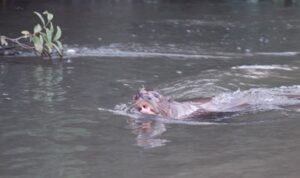 downstream toward us were two chunky, furry, brown periscopes. Warily sizing us up, came a pair of giant river otters. Intermittently scanning their surroundings, by means of this characteristic periscoping behavior, and diving with sinuous grace, the otters passed by within feet of us.
downstream toward us were two chunky, furry, brown periscopes. Warily sizing us up, came a pair of giant river otters. Intermittently scanning their surroundings, by means of this characteristic periscoping behavior, and diving with sinuous grace, the otters passed by within feet of us.
We had just been graced by the presence of the rarest mammal in the Neotropics and one of the rarest in the world. Primarily a predator of fish, giant otters will also prey upon other aquatic animals such as crabs. At nearly six feet in length, they are large enough to feast on small caimans. Sadly, decades of poaching have reduced the population of this “jaguar of the water” to just a few thousand individuals.
Our terrestrial hike had yielded a trove of attention-grabbing bird species and the Salobra was not to be outdone. One after another came sun grebe, maguari stork, thrush-like wren, striated heron, crested oropendola, Amazon kingfisher, and nearly three dozen more in the space of an hour. Coupled with the glut of intriguing aquatic plants, palms, and flowering trees to be seen, the abundance of life in which we were immersed seemed to overload my senses as I drifted along in a state of biological bliss.
Brown capuchin monkeys foraged in the surrounding trees and once,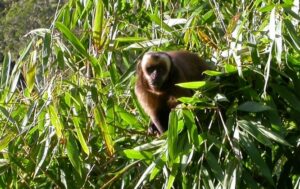 rounding a bend in the stream, we were confronted by a pair of black howler monkeys alternately wading and swimming the narrow channel. Suddenly, finding us upon them, the howlers hurried on with what looked like wide-eyed terror. Doubtless they were uncomfortable at having to ford the stream in the first place. Almost certainly the presence of caiman and anaconda in these waters made swimming an exceedingly risky proposition, and one to be avoided when possible.
rounding a bend in the stream, we were confronted by a pair of black howler monkeys alternately wading and swimming the narrow channel. Suddenly, finding us upon them, the howlers hurried on with what looked like wide-eyed terror. Doubtless they were uncomfortable at having to ford the stream in the first place. Almost certainly the presence of caiman and anaconda in these waters made swimming an exceedingly risky proposition, and one to be avoided when possible.
Soon, as if to confirm this, our boatman Za directed our attention to a small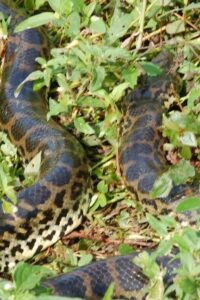 island off our port side. There, lying in the sun, was a yellow anaconda. The snake was hesitant to give up its basking spot and allowed us to beach our canoes and closely approach. While not nearly as large as its cousin the green anaconda (>20 ft. potentially), this was still a snake of impressive proportions and quite capable of taking a young caiman or capybara.
island off our port side. There, lying in the sun, was a yellow anaconda. The snake was hesitant to give up its basking spot and allowed us to beach our canoes and closely approach. While not nearly as large as its cousin the green anaconda (>20 ft. potentially), this was still a snake of impressive proportions and quite capable of taking a young caiman or capybara.
Occasionally we would pull our canoe into a mass of water hyacinth along the shore. Thus anchored we could better observe or photograph a particularly interesting bird. Occasionally this resulted in our receiving a sudden shock as a startled caiman unexpectedly burst from hiding. Lying in the hyacinths,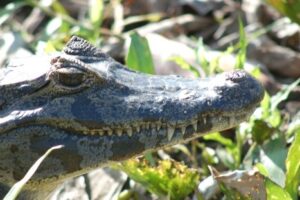 with only their eyes and nostrils above water, the caimans were virtually invisible. A tremendous cannonball-like splash, a drenching cascade of water, and an olive-green blur disappearing beneath the surface would often be our indications that we had nearly beached ourselves upon a caiman.
with only their eyes and nostrils above water, the caimans were virtually invisible. A tremendous cannonball-like splash, a drenching cascade of water, and an olive-green blur disappearing beneath the surface would often be our indications that we had nearly beached ourselves upon a caiman.
Equally disquieting was the sudden rush of a startled capybara as it discovered our presence and bolted headlong into the river. Looking something like a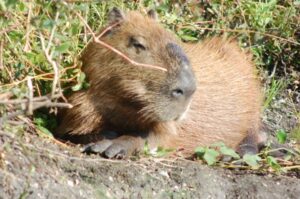 tremendously overgrown guinea pig, these mammals are the largest rodents in the world. They may weigh over one-hundred pounds and stand nearly two feet tall at the shoulder. Capybaras are semiaquatic plant eaters and for them the water is not only a source of food but provides an effective escape from predators such as the jaguar. Capybaras are social animals, and it was not unusual to see small herds of them grazing at what they considered a safe distance from the water’s edge.
tremendously overgrown guinea pig, these mammals are the largest rodents in the world. They may weigh over one-hundred pounds and stand nearly two feet tall at the shoulder. Capybaras are semiaquatic plant eaters and for them the water is not only a source of food but provides an effective escape from predators such as the jaguar. Capybaras are social animals, and it was not unusual to see small herds of them grazing at what they considered a safe distance from the water’s edge.
In addition to the fantastic wildlife sightings, my field notes reveal another experience of great worth. This was the total absence of unnatural sound. Today’s crowded world is filled with distracting, unpleasant sounds: a Jake-braking semi, the roar of an airplane overhead, a wailing siren, the thunderous rumble of a passing train. Finding a place where intrusive sounds are totally absent is a rarity.
Constant exposure to noise pollution is unhealthy. Long-term Impairment of hearing is an obvious consequence. More insidious are the impacts of relentless clamor on heart health, blood pressure, sleep, and psychological well-being. Not without reason, but to our shame, we must acknowledge that humans have used incessant noise as a torture device.
Natural sounds on the other hand are therapeutic. Such sounds reduce stress, they soothe, they effortlessly take us to a meditative realm. Natural sounds arouse the deeply entrenched racial memories of our long evolutionary journey from early hominid to modern human.
The mere recollection of certain natural sounds can transport one back to a remembered, emotive outdoor experience. Not by coincidence do we sometimes see the space voyagers in sci-fi films sitting in meditation as they enjoy flowers, trees, and singing birds courtesy of the hologram deck on their starship.
The loud, liquid warbling of the thrush-like wren’s morning song never fails to elevate my spirit. Even now I can close my eyes, hear its loud bubbly call, and suddenly find myself afloat on a rainforest stream. The warm equatorial sun bathes my shoulders. The rich, organic odor of decaying vegetation and humid air assails my olfactory lobes. I am filled with deep serenity, and I sense a harmony with the natural world surrounding me.
Likewise, the soft, whooping call of the smoky jungle frog plops me back into my hammock in the Peruvian rainforest. Gently swaying to and fro, I listen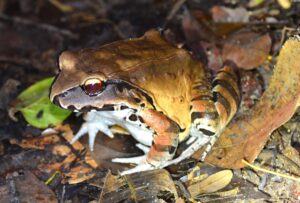 with wonder to the sound of a tropical downpour rapidly advancing my way through the forest. It is the sound of millions of raindrops falling upon millions of leaves. The volume grows and I silently give thanks not only for the thatched palm above my head but my great good fortune in being in this moment.
with wonder to the sound of a tropical downpour rapidly advancing my way through the forest. It is the sound of millions of raindrops falling upon millions of leaves. The volume grows and I silently give thanks not only for the thatched palm above my head but my great good fortune in being in this moment.
The deep, booming voice of the siamang announcing to other gibbons, “this is my territory; here is my troop”, transports me to the magnificent dipterocarp forest of Malaysia. I feel the intense humidity. I smell the fecund odor of the rainforest. I marvel at its rich biodiversity. I stand enthralled as I contemplate such a richness springing from some long-ago stellar cataclysm.
my territory; here is my troop”, transports me to the magnificent dipterocarp forest of Malaysia. I feel the intense humidity. I smell the fecund odor of the rainforest. I marvel at its rich biodiversity. I stand enthralled as I contemplate such a richness springing from some long-ago stellar cataclysm.
“Whip-poor-will, whip-poor-will, whip-poor-will.” Suddenly I am teleported back to my childhood home in rural Indiana. The sun sinks behind Mr. Correll’s cornfield to the west. The hot June day slowly ebbs away. As the menacing darkness falls, I feel the childhood sense of contentment and safety spawned by having a place and a family.
Should I hear in the background of a B-western the harsh, repetitive chuh calls of a cactus wren, I suddenly find myself standing in the Sonoran desert of Arizona. Through the dry, clear desert air I scan the forest of giant saguaros. In vain I struggle to declare a victor in the contest to determine which one really is the most magnificent of its kind.
Arizona. Through the dry, clear desert air I scan the forest of giant saguaros. In vain I struggle to declare a victor in the contest to determine which one really is the most magnificent of its kind.
Such is the power of natural sound and vistas devoid of the symbols of Homo sapiens. Quiescent, lying veiled within our cerebral cortex, reside a plethora of sensory and emotional memories. Such reminiscences need only a cue from a favorite bird, an amorous frog, the boom of a thunderstorm, the flow of water over rock, or the whisper of wind upon pine to be awakened. Such memories constitute perhaps the most delightful, and lasting, gifts the natural world can bestow upon us. The lives of these gifts last as long as our own. Their value transcends gold. Their uniqueness brands them as our most personal possessions. May fate allow you to build such memories as well.
